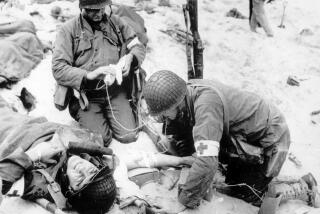Wilfred G. Bigelow, 91; Cardiac Specialist Invented Pacemaker
Dr. Wilfred G. Bigelow, the Canadian surgeon who in the late 1940s pioneered the technique of lowering body temperature to make open-heart surgery possible even though other physicians were certain the procedure would be lethal, died Sunday in his hometown, Toronto. He was 91.
Bigelowâs research on hypothermia also led to his invention of the cardiac pacemaker, but it was not until the invention of the transistor a decade later that the device became practical.
He was âa legendary figure in Canadian medicine and global cardiac surgery,â said Dr. David Naylor, dean of the faculty of medicine at the University of Toronto.
While stationed at a hospital in England early in World War II, Bigelow treated many soldiers with frostbitten limbs, observing that the lowered temperatures reduced the metabolic rate and oxygen requirement of the affected tissue. He and an engineer constructed a device to cool the extremities, allowing him to warm frostbitten limbs more slowly in order to minimize damage.
At warâs end, Bigelow underwent training in cardiovascular surgery at Johns Hopkins University, where Dr. Alfred Blalock was developing surgical techniques to treat âblue babies,â who suffered severe heart defects. Bigelow was in the operating room when the first such surgery was performed in 1947. But the surgery was difficult because patientsâ hearts could not be stopped long enough to allow significant manipulation.
One night, Bigelow awoke with the idea of cooling the entire body to reduce oxygen requirements while the heart was stopped for surgery. His idea contradicted conventional thinking, which held that hypothermia was to be avoided at all costs.
In 1949, back in Toronto, he performed his first heart surgery on a dog whose body temperature had been lowered to 68 degrees. After the heart had been stopped for 15 minutes, Bigelow rewarmed the dog and brought it back to life without apparent damage.
When he reported his results in 1950 at a meeting of the American Surgical Assn., he later recalled, âthere was no discussion. It was one of the very few basic medical discoveries where no one stood up to say theyâd done something similar.â
Three years later, the first successful use of the technique in humans was reported by other researchers.
The development of the heart-lung machine in the 1960s largely supplanted the use of hypothermia during heart surgery, but the two techniques are now often used together when surgeons are performing particularly long operations.
During one of Bigelowâs early studies on hypothermia, a dogâs heart stopped during surgery and Bigelow was unable to restart it using cardiac massage. âI had this probe in my hand,â he recounted later. âOut of interest, and in desperation, I gave the heart a poke. To my surprise, it immediately contracted.â
Further study showed that an electrical impulse delivered by the probe was especially effective in starting the heart. With electrical engineer John Hopps, Bigelow performed studies on dogs and rabbits to determine the optimum voltage and current. Their first pacemaker was a foot long and several inches wide and deep, but it provided the electrical stimulus necessary to keep a heart beating properly during a surgical procedure.
He reported those results at a Boston meeting of the American College of Surgeons in 1950, once more astounding his colleagues.
The first pacemaker was not implanted in a human until 1959, however, when improved electronics made it possible to build a smaller device.
Wilfred Gordon Bigelow was born in Brandon, Canada, in 1913, the son of a country doctor. His rural Manitoba upbringing led to a lifelong passion for the outdoors, including hunting, fishing and golf. He was a longtime chairman and member of the board of trustees of the Nature Conservancy of Canada.
With the exception of his training at Hopkins and his time in the Royal Canadian Army Medical Corps during the war, he spent his entire career at the University of Toronto, retiring in 1979. In 1984, he wrote âCold Hearts,â a book about his life and research. In 1990, he published âMysterious Heparin: The Key to Open Heart Surgery,â a book about the blood thinner heparin.
He won innumerable honors for his surgical contributions.
Bigelow married Margaret Ruth Jennings, who was assistant head nurse at Toronto General Hospital, in 1941. She died in 2000.
He is survived by a daughter, Pixie Bigelow Currie, of Toronto; three sons, Dan of Petersfield, Manitoba, John of Honolulu and William of Toronto; a brother, Dr. Dan Bigelow of Winnipeg; three grandchildren; and three great-grandchildren.






